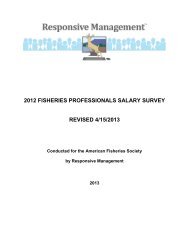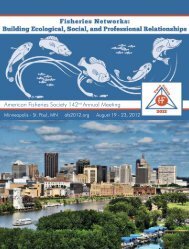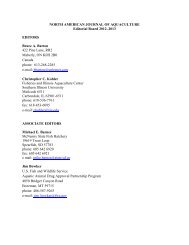Conservation Status of Crayfish Species Paddlefish Conservation ...
Conservation Status of Crayfish Species Paddlefish Conservation ...
Conservation Status of Crayfish Species Paddlefish Conservation ...
Create successful ePaper yourself
Turn your PDF publications into a flip-book with our unique Google optimized e-Paper software.
couldn’t and shouldn’t be asked to give up<br />
any more. The full commission subsequently<br />
compromised and proclaimed that the season<br />
would end on 7 April each year, one<br />
week later than TWRA biologists proposed,<br />
but eight days sooner than the fishers might<br />
have hoped. Additionally, everyone agreed<br />
that no new paddlefish regulations would be<br />
proposed (except for the Mississippi River<br />
paddlefish fishery where possible regulation<br />
changes were still being discussed with border<br />
states) until after the 2009–2010 fishing<br />
season and the effects <strong>of</strong> the new regulations<br />
were evaluated.<br />
LeSSOnS Learned<br />
Initial discouragement following several<br />
<strong>of</strong> the open public meetings turned out to<br />
be unjustified. Although two <strong>of</strong> three public<br />
meetings were unproductive in terms <strong>of</strong><br />
having a meaningful dialogue, they allowed<br />
us to gather the information needed to subsequently<br />
host more productive, facilitated<br />
meetings. Secondly, we suspect that forgoing<br />
the open public meetings and moving right<br />
to a facilitated meeting would have been a<br />
mistake: many fishers were angry that their<br />
industry was being closely scrutinized and they<br />
wanted to make their feelings publicly known.<br />
Thus, the open meetings were a perfect forum<br />
for publicly voicing opposition to the government<br />
(in general) and fisheries scientists<br />
(in particular). Of course, managers should<br />
not think that simply hosting a few boisterous<br />
public meetings and letting stakeholders<br />
vent their anger or frustration will make a<br />
“messy problem” go away. The TWRA made<br />
that mistake in the 1990s when a controversy<br />
erupted over management <strong>of</strong> a trophy<br />
striped bass (Morone saxatilis) fishery, which<br />
pitted anglers targeting that transplanted species<br />
against anglers pursuing native species<br />
such as walleyes (Sander vitreus) and crappies<br />
(Pomoxis spp.; Churchill et al. 2002).<br />
The fact that commercial paddlefish fishers<br />
and industry representatives were given<br />
multiple opportunities in different settings to<br />
participate in the regulatory process (Table<br />
2) was clearly not lost on members <strong>of</strong> the<br />
TWRC. Although not all <strong>of</strong> the regulations<br />
proposed by the TWRA staff were adopted,<br />
the TWRC’s actions at the September 2005<br />
meeting collectively represented the largest<br />
steps ever taken by the TWRC to conserve<br />
the resource. Additional proposals to further<br />
restrict fishing were also entertained (and<br />
compromise versions were enacted) by the<br />
TWRC at their September 2006 meeting.<br />
Although the regulations currently in effect<br />
will probably not help rebuild the stock <strong>of</strong><br />
paddlefish in the lower Tennessee River,<br />
the TWRC noted that stronger measures<br />
to rebuild the stock would be considered if<br />
future sampling indicates such measures are<br />
necessary.<br />
How did the USFWS and its dMA staff<br />
react to what was (or was not) accomplished<br />
to protect paddlefish in the lower Tennessee<br />
River? The dMA was kept apprised during<br />
the regulatory process and indicated that (1)<br />
the regulations passed in September <strong>of</strong> 2005<br />
and 2006 were positive first steps towards conserving<br />
the resource, and (2) export permits<br />
would be provided to purveyors <strong>of</strong> Tennessee<br />
paddlefish caviar (M. Maltese, dMA, pers.<br />
comm.). The dMA also indicated that future<br />
requests for export permits would not be automatically<br />
granted.<br />
The 2005–2006 and 2006–2007 commercial<br />
paddlefish seasons in Tennessee proceeded<br />
against the backdrop <strong>of</strong> a recent ban on the<br />
importation into the United States <strong>of</strong> caviar<br />
from beluga sturgeon (Huso huso), followed<br />
by a CITES ban (albeit temporary) on the<br />
exportation <strong>of</strong> other sturgeon products (e.g.,<br />
sevruga caviar from Acipenser stellatus) from<br />
Caspian Sea states. Perhaps not coincidentally,<br />
the wholesale prices for paddlefish roe in<br />
Tennessee jumped from around US$110/kg<br />
in 2004–2005 to US$143-187/kg during the<br />
2005–2006 season; in some locales during<br />
the 2006–2007 season, fishers were receiving<br />
more than US$200/kg for paddlefish roe<br />
taken from Tennessee waters. In other words,<br />
negotiations to more tightly regulate paddlefish<br />
harvest in Tennessee occurred at a time<br />
when a single large female carrying 3.5 kg <strong>of</strong><br />
roe was worth more than US$650 wholesale<br />
(and twice that or more at retail prices). The<br />
new Tennessee regulations, coupled with rising<br />
prices for paddlefish roe, may be contributing<br />
to increased commercial fishing activity<br />
on the Ohio River, particularly by Tennessee<br />
residents (d. Henley, Kentucky department<br />
<strong>of</strong> Fish and Wildlife, pers. comm.). These<br />
observations serve as justification for biologists<br />
throughout the Mississippi River basin<br />
to continue to work together to monitor their<br />
respective paddlefish fisheries, and for the<br />
dMA to continue to scrutinize requests for<br />
export permits for paddlefish roe, especially if<br />
unambiguous signs <strong>of</strong> overfishing exist.<br />
In conclusion, our approach to assessing<br />
the likelihood <strong>of</strong> overfishing, communicating<br />
research findings, and moving paddlefish<br />
management and conservation in Tennessee<br />
into the twenty-first century yielded positive<br />
results. Our approach could be summarized<br />
as (1) conduct a fishery independent stock<br />
assessment that can withstand peer-scrutiny,<br />
(2) interact with fishers and provide them<br />
with opportunities to participate in data collections,<br />
(3) carefully schedule how, when,<br />
and where research findings and management<br />
recommendations will be presented to<br />
the industry and decision makers, (4) provide<br />
ample and varied opportunities for fishers to<br />
learn about the research and participate in<br />
crafting new regulations, and (5) take what-<br />
table 2. list <strong>of</strong> presentations and meetings during the regulatory process with commercial paddlefish fishers, the Tennessee Wildlife Resource Agency (TWRA) staff, and<br />
the Tennessee Wildlife Resource commission (TWRc). A powerpoint presentation was made at every meeting except the August 2005 facilitated meeting.<br />
date Audience and type <strong>of</strong> meeting objective or Action<br />
April 2005 TWRA administrators and senior staff presented final report findings and recommendations.<br />
April 2005 TWRc monthly meeting presented final report findings and recommendations to commissioners and the public.<br />
June 2005 open public meeting presented final report findings and recommendations to commercial fishers in and around chattanooga,<br />
Tennessee; solicited comments.<br />
June 2005 open public meeting presented final report findings and recommendations to commercial fishers in and around Jackson, Tennessee;<br />
solicited comments.<br />
une 2005 open public meeting presented final report findings and recommendations to commercial fishers in and around Nashville,<br />
Tennessee; solicited comments.<br />
July 2005 TWRc monthly meeting Argued against opening up new waters to paddlefish harvest; unveiled proposed new regulations.<br />
August 2005 Facilitated meeting proposed new harvest regulations to commercial fishers and solicited their comments; sought consensus.<br />
September 2005 TWRc monthly meeting commissioners voted on proposed new regulations.<br />
June 2006 Facilitated meeting Reviewed past season’s harvest data and sought consensus on management actions that should be proposed<br />
to further restrict harvest.<br />
September 2006 TWRc Monthly meeting commissioners voted on proposed new regulations<br />
396 Fisheries • vol 32 no 8 • august 2007 • www.fisheries.org







